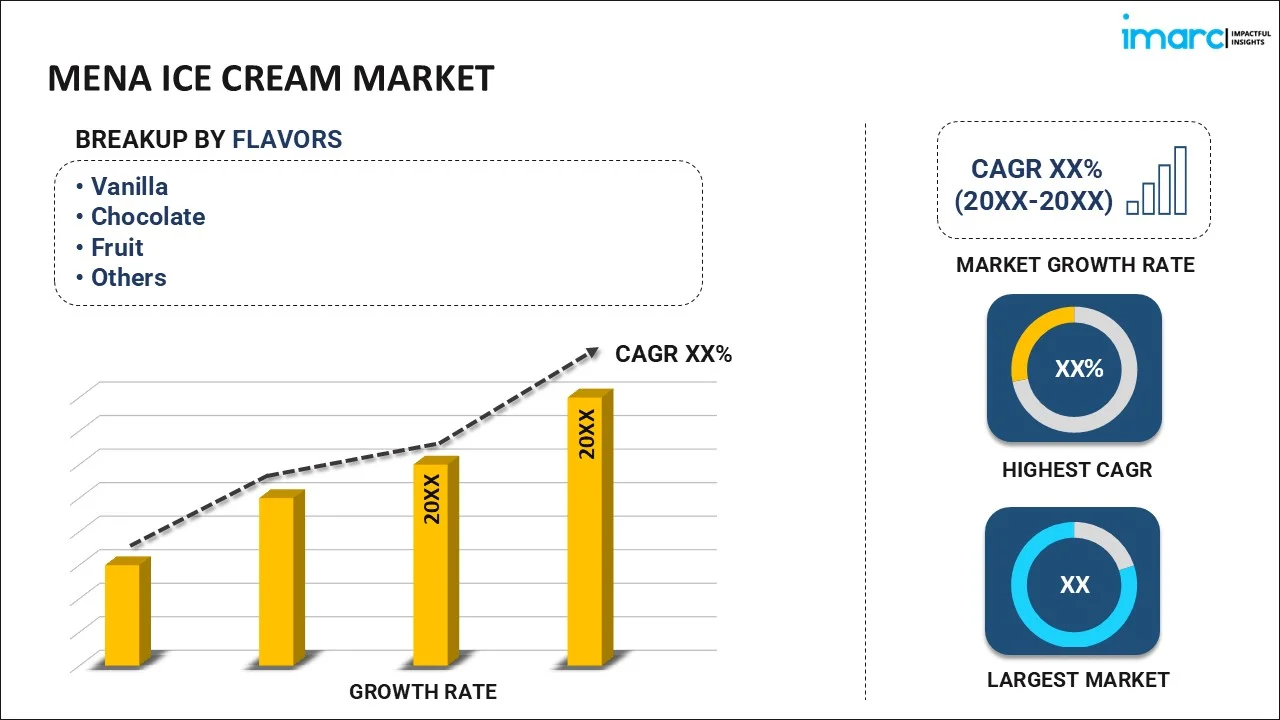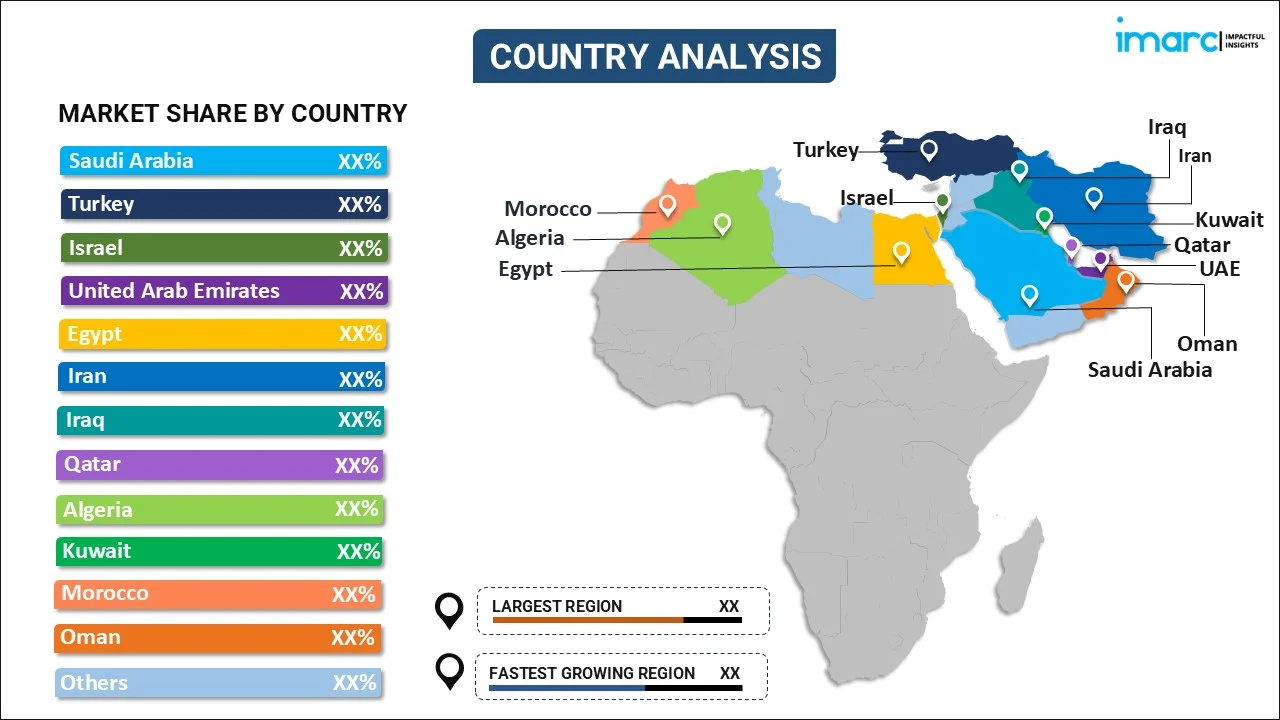
MENA Ice Cream Market Report by Flavor (Vanilla, Chocolate, Fruit, and Others), Category (Impulse Ice Cream, Take-Home Ice Cream, Artisanal Ice Cream), Product (Cup, Stick, Cone, Brick, Tub, and Others), Distribution Channel (Supermarkets and Hypermarkets, Convenience Stores, Ice Cream Parlors, Online Stores, and Others), and Country 2024-2032
Market Overview:
MENA ice cream market size is projected to exhibit a growth rate (CAGR) of 5.31% during 2024-2032. The changing consumer preferences, rising disposable income levels, hot climate across the region, growing health and wellness trends, rapid retail expansion, wide cultural diversity, and aggressive marketing and promotional activities, and expanding tourism and hospitality industry represent some of the key factors driving the market.
|
Report Attribute
|
Key Statistics
|
|---|---|
|
Base Year
|
2023 |
|
Forecast Years
|
2024-2032 |
|
Historical Years
|
2018-2023
|
| Market Growth Rate (2024-2032) | 5.31% |
Ice cream is a popular frozen dessert consumed by individuals of all ages around the world. It is typically made from a combination of simple ingredients, including milk, cream, sugar, and flavorings. The mixture is churned and frozen to create a delightful treat known for its creamy texture and wide variety of flavors. One of the key elements that make ice cream so beloved is its versatility. It comes in an array of flavors, ranging from classic vanilla and chocolate to more exotic options like mango, pistachio, and lavender. In addition to traditional scoops served in cones or cups, ice cream is also a key ingredient in various desserts, such as sundaes, milkshakes, and ice cream sandwiches.
MENA Ice Cream Market Trends:
One of the primary factors driving the MENA ice cream market is the evolving taste and preferences of consumers. As lifestyles become more urbanized and modern, consumers are increasingly seeking indulgent and innovative ice cream flavors and products. This shift has led to a surge in demand for premium and artisanal ice creams. Additionally, the growing affluence in many MENA countries has resulted in increased disposable income among consumers. As a result, consumers are more willing to spend on premium and higher-priced ice cream products, such as gelato, sorbet, and imported ice creams, boosting market revenues. Other than this, the hot climate prevalent in several MENA countries is significantly escalating the demand for ice cream. Ice cream is seen as a dessert and also as a way to cool down and refresh during scorching summers. This climatic factor drives year-round consumption and sales. Besides this, health-conscious consumers are seeking healthier ice cream options. As a response, the market has witnessed the emergence of low-fat, low-sugar, and dairy-free alternatives. Manufacturers are also incorporating natural and organic ingredients to cater to this segment. In line with this, the MENA region is culturally diverse, and this diversity extends to culinary preferences. Ice cream manufacturers are capitalizing on this by offering flavors and ingredients that resonate with local tastes and traditions. Unique flavors like saffron, pistachio, and rosewater are gaining popularity. Furthermore, aggressive marketing and promotional activities by ice cream brands and manufacturers have also contributed to market growth. Creative advertising campaigns, special promotions, and tie-ins with events and festivals have helped boost consumer interest and consumption. Moreover, the MENA region is a popular tourist destination, and the hospitality industry plays a significant role in driving ice cream sales. Hotels, resorts, and restaurants often feature ice cream on their menus, attracting tourists and locals alike.
MENA Ice Cream Market Segmentation:
IMARC Group provides an analysis of the key trends in each segment of the market, along with forecasts at the regional and country levels for 2024-2032. Our report has categorized the market based on flavor, category, product, and distribution channel.
Flavor Insights:

- Vanilla
- Chocolate
- Fruit
- Others
The report has provided a detailed breakup and analysis of the market based on the flavor. This includes vanilla, chocolate, fruit, and others.
Category Insights:
- Impulse Ice Cream
- Take-Home Ice Cream
- Artisanal Ice Cream
A detailed breakup and analysis of the market based on the category have also been provided in the report. This includes impulse ice cream, take-home ice cream, and artisanal ice cream.
Product Insights:
- Cup
- Stick
- Cone
- Brick
- Tub
- Others
The report has provided a detailed breakup and analysis of the market based on the product. This includes cup, stick, cone, brick, tub, and others.
Distribution Channel Insights:
- Supermarkets and Hypermarkets
- Convenience Stores
- Ice Cream Parlors
- Online Stores
- Others
A detailed breakup and analysis of the market based on the distribution channel have also been provided in the report. This includes supermarkets and hypermarkets, convenience stores, ice cream parlors, online stores, and others.
Country Insights:

- Saudi Arabia
- Turkey
- Israel
- United Arab Emirates
- Egypt
- Iran
- Iraq
- Qatar
- Algeria
- Kuwait
- Morocco
- Oman
- Others
The report has also provided a comprehensive analysis of all the major regional markets, which include Saudi Arabia, Turkey, Israel, United Arab Emirates, Egypt, Iran, Iraq, Qatar, Algeria, Kuwait, Morocco, Oman, and Others.
Competitive Landscape:
The market research report has also provided a comprehensive analysis of the competitive landscape. Competitive analysis such as market structure, key player positioning, top winning strategies, competitive dashboard, and company evaluation quadrant has been covered in the report. Also, detailed profiles of all major companies have been provided.
MENA Ice Cream Market Report Coverage:
| Report Features | Details |
|---|---|
| Base Year of the Analysis | 2023 |
| Historical Period | 2018-2023 |
| Forecast Period | 2024-2032 |
| Units | US$ Million |
| Scope of the Report | Exploration of Historical Trends and Market Outlook, Industry Catalysts and Challenges, Segment-Wise Historical and Future Market Assessment:
|
| Flavors Covered | Vanilla, Chocolate, Fruit, Others |
| Categories Covered | Impulse Ice Cream, Take-Home Ice Cream, Artisanal Ice Cream |
| Products Covered | Cup, Stick, Cone, Brick, Tub, Others |
| Distribution Channels Covered | Supermarkets and Hypermarkets, Convenience Stores, Ice Cream Parlors, Online Stores, Others |
| Countries Covered | Saudi Arabia, Turkey, Israel, United Arab Emirates, Egypt, Iran, Iraq, Qatar, Algeria, Kuwait, Morocco, Oman, Others |
| Customization Scope | 10% Free Customization |
| Report Price and Purchase Option | Single User License: US$ 3699 Five User License: US$ 4699 Corporate License: US$ 5699 |
| Post-Sale Analyst Support | 10-12 Weeks |
| Delivery Format | PDF and Excel through Email (We can also provide the editable version of the report in PPT/Word format on special request) |
Key Questions Answered in This Report:
- How has the MENA ice cream market performed so far and how will it perform in the coming years?
- What has been the impact of COVID-19 on the MENA ice cream market?
- What is the breakup of the MENA ice cream market on the basis of flavor?
- What is the breakup of the MENA ice cream market on the basis of category?
- What is the breakup of the MENA ice cream market on the basis of product?
- What is the breakup of the MENA ice cream market on the basis of distribution channel?
- What are the various stages in the value chain of the MENA ice cream market?
- What are the key driving factors and challenges in the MENA ice cream?
- What is the structure of the MENA ice cream market and who are the key players?
- What is the degree of competition in the MENA ice cream market?
Key Benefits for Stakeholders:
- IMARC’s industry report offers a comprehensive quantitative analysis of various market segments, historical and current market trends, market forecasts, and dynamics of the MENA ice cream market from 2018-2032.
- The research report provides the latest information on the market drivers, challenges, and opportunities in the MENA ice cream market.
- Porter's five forces analysis assist stakeholders in assessing the impact of new entrants, competitive rivalry, supplier power, buyer power, and the threat of substitution. It helps stakeholders to analyze the level of competition within the MENA ice cream industry and its attractiveness.
- Competitive landscape allows stakeholders to understand their competitive environment and provides an insight into the current positions of key players in the market.
Need more help?
- Speak to our experienced analysts for insights on the current market scenarios.
- Include additional segments and countries to customize the report as per your requirement.
- Gain an unparalleled competitive advantage in your domain by understanding how to utilize the report and positively impacting your operations and revenue.
- For further assistance, please connect with our analysts.
 Inquire Before Buying
Inquire Before Buying
 Speak to an Analyst
Speak to an Analyst
 Request Brochure
Request Brochure
 Request Customization
Request Customization




.webp)




.webp)












